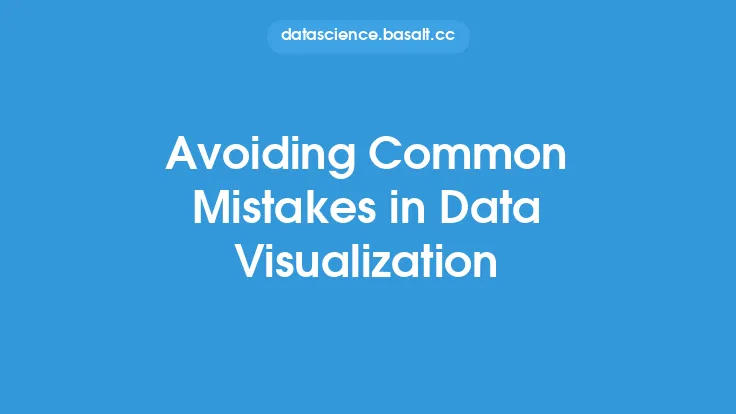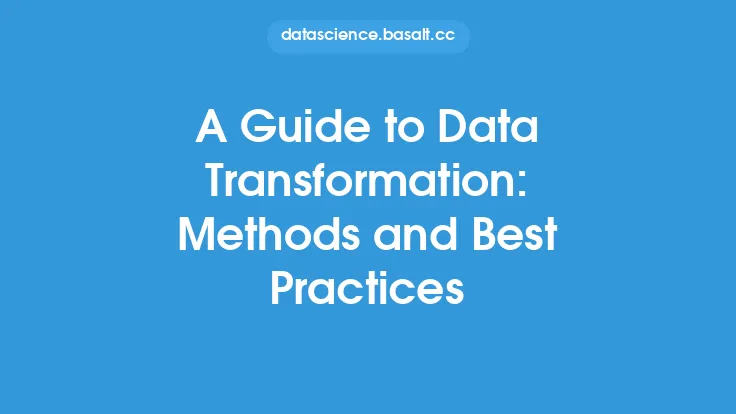When working with data, transformation is a crucial step that can significantly impact the outcome of any analysis or modeling task. Data transformation involves converting data from one format to another to make it more suitable for analysis, modeling, or visualization. However, this process can be prone to errors if not done correctly. In this article, we will discuss common data transformation mistakes to avoid, ensuring that your data is accurate, reliable, and ready for analysis.
Introduction to Data Transformation Mistakes
Data transformation mistakes can arise from various sources, including incorrect data type conversions, inappropriate handling of missing values, and inadequate data normalization. These mistakes can lead to biased models, incorrect conclusions, and poor decision-making. To avoid these pitfalls, it is essential to understand the common mistakes that can occur during data transformation and take steps to prevent them. This includes being aware of the data types, handling missing values appropriately, and applying suitable normalization techniques.
Incorrect Data Type Conversions
One of the most common data transformation mistakes is incorrect data type conversions. This can occur when converting data from one type to another, such as converting a numeric column to a categorical column. Incorrect data type conversions can lead to loss of information, incorrect calculations, and biased models. For example, converting a date column to a numeric column can result in incorrect calculations and loss of temporal information. To avoid this mistake, it is essential to understand the data types and ensure that conversions are done correctly. This can be achieved by using data profiling techniques to understand the distribution of values in each column and applying appropriate data type conversions.
Inadequate Handling of Missing Values
Missing values are a common problem in data analysis, and inadequate handling of missing values can lead to biased models and incorrect conclusions. There are several ways to handle missing values, including listwise deletion, pairwise deletion, mean imputation, and regression imputation. However, each method has its limitations, and the choice of method depends on the nature of the data and the analysis task. For example, listwise deletion can lead to biased estimates if the missing values are not missing completely at random. To avoid this mistake, it is essential to understand the nature of the missing values and apply appropriate handling techniques. This can be achieved by using data visualization techniques to understand the distribution of missing values and applying suitable imputation methods.
Inadequate Data Normalization
Data normalization is an essential step in data transformation, as it ensures that all variables are on the same scale. Inadequate data normalization can lead to biased models, incorrect conclusions, and poor decision-making. There are several normalization techniques, including min-max scaling, standardization, and logarithmic transformation. However, each technique has its limitations, and the choice of technique depends on the nature of the data and the analysis task. For example, min-max scaling can be sensitive to outliers, while standardization can be sensitive to non-normality. To avoid this mistake, it is essential to understand the distribution of values in each column and apply suitable normalization techniques. This can be achieved by using data visualization techniques to understand the distribution of values and applying suitable normalization methods.
Ignoring Data Distribution
Ignoring data distribution is another common data transformation mistake. Data distribution can significantly impact the choice of analysis technique, and ignoring it can lead to biased models and incorrect conclusions. For example, assuming normality when the data is skewed can lead to incorrect conclusions. To avoid this mistake, it is essential to understand the data distribution and apply suitable analysis techniques. This can be achieved by using data visualization techniques to understand the distribution of values and applying suitable transformation methods.
Not Documenting Data Transformation
Not documenting data transformation is a critical mistake that can lead to reproducibility issues and poor decision-making. Data transformation is a complex process that involves several steps, and not documenting these steps can make it difficult to reproduce the results. To avoid this mistake, it is essential to document all data transformation steps, including data type conversions, handling of missing values, and data normalization. This can be achieved by using data transformation pipelines and documenting each step in the pipeline.
Conclusion
Data transformation is a critical step in data analysis, and common mistakes can lead to biased models, incorrect conclusions, and poor decision-making. By understanding the common data transformation mistakes, including incorrect data type conversions, inadequate handling of missing values, inadequate data normalization, ignoring data distribution, and not documenting data transformation, you can take steps to prevent them. This includes being aware of the data types, handling missing values appropriately, applying suitable normalization techniques, understanding the data distribution, and documenting all data transformation steps. By avoiding these mistakes, you can ensure that your data is accurate, reliable, and ready for analysis, leading to better decision-making and improved outcomes.





